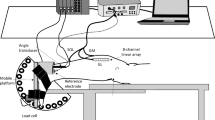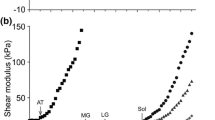Abstract
The purpose of this study was to investigate the effect of 2 weeks of ankle joint immobilization on triceps surae neural activation, with particular emphasis on the potential differences between the monoarticular soleus and the biarticular gastrocnemius muscles. Seventeen male volunteers were divided into the immobilized group (IG, n=8) and the control group (CG, n=9). Elastic adhesive bandages and an ankle stabilization orthosis were used to immobilize the ankle joint only. The plantar flexor torque obtained during maximal voluntary contractions (MVC) and after single, paired and tetanic stimuli applied at rest was measured. The associated EMG activity from the soleus and gastrocnemius muscles was also recorded, and their activation levels were estimated by means of the twitch interpolation technique. After immobilization, triceps surae maximal voluntary torque significantly decreased by 17% (P<0.001). Strength losses were accompanied by a decrement in activation level (−6%, average of the three techniques used) and in maximal 100 Hz tetanic force (−11%). A significant decrease in the soleus (−22%, P<0.05) but not in the gastrocnemius EMG activity, normalized to respective M-waves, was also found. It was concluded that the reduced voluntary torque output after immobilization could be attributed to both muscular and neural alterations. These latter selectively involved the monoarticular soleus muscle, while neural drive to the biarticular gastrocnemii, which had not been immobilized in their function as knee flexors, was preserved.


Similar content being viewed by others
References
Antonutto G, Capelli C, Girardis M, Zamparo P, di Prampero PE (1999) Effects of microgravity on maximal power of lower limbs during very short efforts in humans. J Appl Physiol 86:85–92
Behm DG, St-Pierre DM, Perez D (1996) Muscle inactivation: assessment of interpolated twitch technique. J Appl Physiol 81:2267–2273
Berg HE, Tesch PA (1996) Changes in muscle function in response to 10 days of lower limb unloading in humans. Acta Physiol Scand 157:63–70
Booth FW (1982) Effect of limb immobilization on skeletal muscle. J Appl Physiol 52:1113–1118
Davies CT, Rutherford IC, Thomas DO (1987) Electrically evoked contractions of the triceps surae during and following 21 days of voluntary leg immobilization. Eur J Appl Physiol Occup Physiol 56:306–312
Deschenes MR, Giles JA, McCoy RW, Volek JS, Gomez AL, Kraemer WJ (2002) Neural factors account for strength decrements observed after short-term muscle unloading. Am J Physiol Regul Integr Comp Physiol 282:R578–R583
Desmedt JE, Hainaut K (1968) Kinetics of myofilament activation in potentiated contraction: staircase phenomenon in human skeletal muscle. Nature 217:529–532
Duchateau J, Hainaut K (1987) Electrical and mechanical changes in immobilized human muscle. J Appl Physiol 62:2168–2173
Duchateau J, Hainaut K (1990) Effects of immobilization on contractile properties, recruitment and firing rates of human motor units. J Physiol (Lond) 422:55–65
Dudley GA, Duvoisin MR, Adams GR, Meyer RA, Belew AH, Buchanan P (1992) Adaptations to unilateral lower limb suspension in humans. Aviat Space Environ Med 63:678–683
Gardetto PR, Schluter JM, Fitts RH (1989) Contractile function of single muscle fibers after hindlimb suspension. J Appl Physiol 66:2739–2749
Grana EA, Chiou-Tan F, Jaweed MM (1996) Endplate dysfunction in healthy muscle following a period of disuse. Muscle Nerve 19:989–993
Hespel P, Op’t Eijnde B, Van Leemputte M, Urso B, Greenhaff PL, Labarque V, Dymarkowski S, Van Hecke P, Richter EA (2001) Oral creatine supplementation facilitates the rehabilitation of disuse atrophy and alters the expression of muscle myogenic factors in humans. J Physiol (Lond) 536:625–633
Hortobagyi T, Dempsey L, Fraser D, Zheng D, Hamilton G, Lambert J, Dohm L (2000) Changes in muscle strength, muscle fibre size and myofibrillar gene expression after immobilization and retraining in humans. J Physiol (Lond) 524:293–304
Kawakami Y, Akima H, Kubo K, Muraoka Y, Hasegawa H, Kouzaki M, Imai M, Suzuki Y, Gunji A, Kanehisa H, Fukunaga T (2001) Changes in muscle size, architecture, and neural activation after 20 days of bed rest with and without resistance exercise. Eur J Appl Physiol 84:7–12
Kent-Braun JA, Le Blanc R (1996) Quantitation of central activation failure during maximal voluntary contractions in humans. Muscle Nerve 19:861–869
Kitahara A, Hamaoka T, Murase N, Homma T, Kurosawa Y, Ueda C, Nagasawa T, Ichimura S, Motobe M, Yashiro K, Nakano S, Katsumura T (2003) Deterioration of muscle function after 21-day forearm immobilization. Med Sci Sports Exerc 35:1697–1702
Klass M, Guissard N, Duchateau J (2004) Limiting mechanisms of force production after repetitive dynamic contractions in human triceps surae. J Appl Physiol 96:1516–1521
Larsson L, Li X, Berg HE, Frontera WR (1996) Effects of removal of weight-bearing function on contractility and myosin isoform composition in single human skeletal muscle cells. Pflugers Arch 432:320–328
Miles MP, Clarkson PM, Bean M, Ambach K, Mulroy J, Vincent K (1994) Muscle function at the wrist following 9 days of immobilization and suspension. Med Sci Sports Exerc 26:615–623
Narici M, Kayser B, Barattini P, Cerretelli P (2003) Effects of 17-day spaceflight on electrically evoked torque and cross-sectional area of the human triceps surae. Eur J Appl Physiol 90:275–282
Schulze K, Gallagher P, Trappe S (2002) Resistance training preserves skeletal muscle function during unloading in humans. Med Sci Sports Exerc 34:303–313
Seki K, Taniguchi Y, Narusawa M (2001a) Effects of joint immobilization on firing rate modulation of human motor units. J Physiol (Lond) 530:507–519
Seki K, Taniguchi Y, Narusawa M (2001b) Alterations in contractile properties of human skeletal muscle induced by joint immobilization. J Physiol (Lond) 530:521–532
Thom JM, Thompson MW, Ruell PA, Bryant GJ, Fonda JS, Harmer AR, De Jonge XA, Hunter SK (2001) Effect of 10-day cast immobilization on sarcoplasmic reticulum calcium regulation in humans. Acta Physiol Scand 172:141–147
Vandenborne K, Elliott MA, Walter GA, Abdus S, Okereke E, Shaffer M, Tahernia D, Esterhai JL (1998) Longitudinal study of skeletal muscle adaptations during immobilization and rehabilitation. Muscle Nerve 21:1006–1012
Veldhuizen JW, Verstappen FT, Vroemen JP, Kuipers H, Greep JM (1993) Functional and morphological adaptations following four weeks of knee immobilization. Int J Sports Med 14:283–287
White MJ, Davies CT, Brooksby P (1984) The effects of short-term voluntary immobilization on the contractile properties of the human triceps surae. Q J Exp Physiol 69:685–691
Widrick JJ, Knuth ST, Norenberg KM, Romatowski JG, Bain JL, Riley DA, Karhanek M, Trappe SW, Trappe TA, Costill DL, Fitts RH (1999) Effect of a 17 day spaceflight on contractile properties of human soleus muscle fibres. J Physiol (Lond) 516:915–930
Acknowledgements
The authors are indebted to the eight subjects who endured 2 weeks of ankle joint immobilization and to Mr Yves Ballay for his excellent technical assistance.
Author information
Authors and Affiliations
Corresponding author
Rights and permissions
About this article
Cite this article
Gondin, J., Guette, M., Maffiuletti, N.A. et al. Neural activation of the triceps surae is impaired following 2 weeks of immobilization. Eur J Appl Physiol 93, 359–365 (2004). https://doi.org/10.1007/s00421-004-1225-z
Accepted:
Published:
Issue Date:
DOI: https://doi.org/10.1007/s00421-004-1225-z




